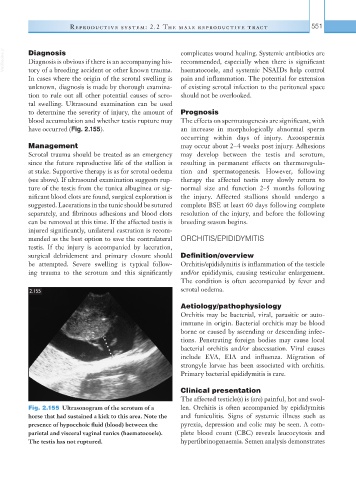Page 576 - Equine Clinical Medicine, Surgery and Reproduction, 2nd Edition
P. 576
Reproductive system: 2.2 The male reproductive tr act 551
VetBooks.ir Diagnosis complicates wound healing. Systemic antibiotics are
recommended, especially when there is significant
Diagnosis is obvious if there is an accompanying his-
tory of a breeding accident or other known trauma.
pain and inflammation. The potential for extension
In cases where the origin of the scrotal swelling is haematocoele, and systemic NSAIDs help control
unknown, diagnosis is made by thorough examina- of existing scrotal infection to the peritoneal space
tion to rule out all other potential causes of scro- should not be overlooked.
tal swelling. Ultrasound examination can be used
to determine the severity of injury, the amount of Prognosis
blood accumulation and whether testis rupture may The effects on spermatogenesis are significant, with
have occurred (Fig. 2.155). an increase in morphologically abnormal sperm
occurring within days of injury. Azoospermia
Management may occur about 2–4 weeks post injury. Adhesions
Scrotal trauma should be treated as an emergency may develop between the testis and scrotum,
since the future reproductive life of the stallion is resulting in permanent effects on thermoregula-
at stake. Supportive therapy is as for scrotal oedema tion and spermatogenesis. However, following
(see above). If ultrasound examination suggests rup- therapy the affected testis may slowly return to
ture of the testis from the tunica albuginea or sig- normal size and function 2–5 months following
nificant blood clots are found, surgical exploration is the injury. Affected stallions should undergo a
suggested. Lacerations in the tunic should be sutured complete BSE at least 60 days following complete
separately, and fibrinous adhesions and blood clots resolution of the injury, and before the following
can be removed at this time. If the affected testis is breeding season begins.
injured significantly, unilateral castration is recom-
mended as the best option to save the contralateral ORCHITIS/EPIDIDYMITIS
testis. If the injury is accompanied by laceration,
surgical debridement and primary closure should Definition/overview
be attempted. Severe swelling is typical follow- Orchitis/epididymitis is inflammation of the testicle
ing trauma to the scrotum and this significantly and/or epididymis, causing testicular enlargement.
The condition is often accompanied by fever and
2.155 scrotal oedema.
Aetiology/pathophysiology
Orchitis may be bacterial, viral, parasitic or auto-
immune in origin. Bacterial orchitis may be blood
borne or caused by ascending or descending infec-
tions. Penetrating foreign bodies may cause local
bacterial orchitis and/or abscessation. Viral causes
include EVA, EIA and influenza. Migration of
strongyle larvae has been associated with orchitis.
Primary bacterial epididymitis is rare.
Clinical presentation
The affected testicle(s) is (are) painful, hot and swol-
Fig. 2.155 Ultrasonogram of the scrotum of a len. Orchitis is often accompanied by epididymitis
horse that had sustained a kick to this area. Note the and funiculitis. Signs of systemic illness such as
presence of hypoechoic fluid (blood) between the pyrexia, depression and colic may be seen. A com-
parietal and visceral vaginal tunics (haematocoele). plete blood count (CBC) reveals leucocytosis and
The testis has not ruptured. hyperfibrinogenaemia. Semen analysis demonstrates

